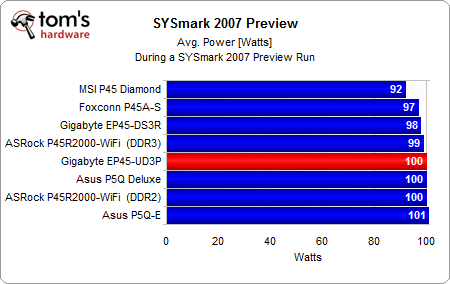Ultra Durable 3: Extra Copper, Benchmarked
Performance Per Watt And Temperature
The average power required during a full SYSmark 2007 Preview run was 100 W for the system utilizing the EP45-UD3P with Ultra Durable 3 technology. There were no interesting results in this category.
The energy used to complete a full SYSmark 2007 Preview run was 131 watt-hours, which also is an average result.
Looking at the SYSmark 2007 Preview performance scores divided by the watt-hours used to complete the workload, Gigabyte’s new Ultra Durable 3 motherboard does just as well as the EP45-DS3R, which comes with the regular amount of copper.
Memory Voltage Reduction
After discussing with Gigabyte, the firm recommended we try a high-speed DDR2 memory setup, as the Ultra Durable 3 board is expected to run its DDR2 memory at high speed using less voltage than the DS3R board. We wanted to look into this and grabbed two Corsair XM2X1024-10000C5D DIMMs, which we set to DDR2-1200 speed at CL5-5-5-18 timings.
Gigabyte said that the added copper in its Ultra Durable 3 boards allows to reduce memory voltage by 0.2 V. We set the FSB speed to 300 MHz and selected DDR2-1200 memory speed. All other voltages except memory remained at their default settings. We then went ahead and looked for the lowest possible memory voltage that allowed stable operation of Prime95 for at least 30 minutes.
| Motherboard | Lowest Stable Memory Voltage @ DDR2-1200 |
|---|---|
| EP45-UD3P (Ultra Durable 3) | 2.160V |
| EP45-DS3R | 2.20V |
We had to use 2.2 V on the EP45-DS3R board, and we started with the same voltage using the UD3P Ultra Durable 3 motherboard. 2.16 V was the lowest stable memory voltage setting, which is a 0.04 V difference. That’s not much, but at least something.
Get Tom's Hardware's best news and in-depth reviews, straight to your inbox.
Motherboard Peak Temperature
We found that the Gigabyte EP45-UD3P reached a peak temperature of 69°C, measured in the vicinity of the voltage regulators, but on the lower side of the motherboard because temperature would not be influenced by the CPU fan or other airflow. We measured this temperature after a 30 minute session with Prime95, which is a useful tool to stress a processor. The Core 2 Extreme QX6850 was overclocked to 3.33 GHz at a 1.4 V voltage, so we could make sure that we apply a maximum load to the motherboard voltage regulators.
The Gigabyte EP45-DS3R, which does not feature Ultra Durable 3 with additional copper, reached peak temperatures of 90°C, which is considerably more. Part of the difference has to be accounted to the UD3P’s heat sinks. If these are removed, the UD3’s peak temperature increases from 69 to 86°C, which is still a good result, showing that the additional copper has at least a minor positive impact here.
| Motherboard | Temperature of VR on Board Back-side |
|---|---|
| EP45-UD3P (with cooler) | 69°C |
| EP45-UD3P (without cooler) | 86°C |
| EP45-DS3R (no cooler) | 90°C |
Current page: Performance Per Watt And Temperature
Prev Page Idle And Peak Power, DES Efficiency Next Page Conclusion

